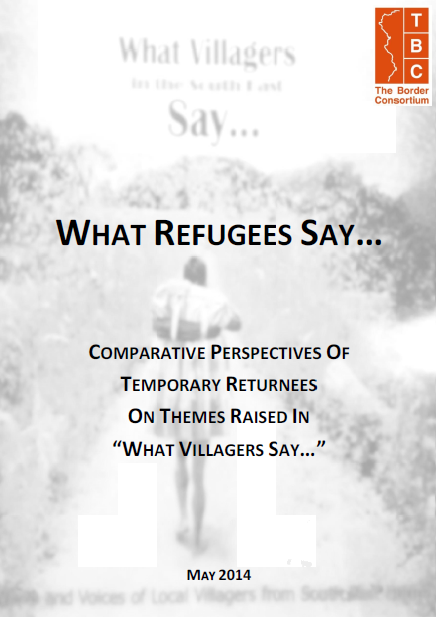What Refugees Say…
By The Border Consortium • August 10, 2014Between March‐April this year, focus group discussions were held with temporary returnees to SE Burma/ Myanmar from all 9 refugee camps along the Thailand‐Burma/ Myanmar border. The aim was to gain a snapshot of individual perspectives and concerns on current conditions on the ground, rather than conducting a formal survey representational of the whole refugee caseload.
The consultations focused on the conditions in the areas they returned to, the changes they and residents in those areas had detected since recent political and military shifts in the country, and their perceived current barriers to return.
The participants were identified by Section Leaders, with criteria that they must have returned to SE Burma/ Myanmar since the ceasefires were brokered, be adults, and that there should be some gender equity amongst them. In total, 85 temporary returnees participated in the consultations, with 35% being female. Over 100 others, comprising senior community leaders and CBO staff were also engaged through the process, although the main findings in this report only reflect the perspectives of those who had recently returned to their country of origin.
Prior to the discussions, the participants were invited to self‐profile themselves to contextualize their movements. This involved them voluntarily providing the date, length, destination and purpose of their last visit, as well as the route by which they returned.
The destinations of their returns were mainly to rural upland areas encompassing at least 18 townships in all States and Regions in SE Burma/ Myanmar (except Shan State) – the majority for family‐related reasons, and lasting from 1 day to 9 months.
Based on their testimonies and reported perspectives, there are substantial barriers to sustainable return, especially in areas associated with high levels of continued militarization, with the ability to enjoy basic rights and freedoms not yet guaranteed by any functioning rule of law.
Although the severe insecurity associated with continued militarization is a universal and critical concern across all camps and in all areas visited, the nature and levels of other obstacles varied between camps and the areas temporary returned to. Barriers to livelihoods security and land tenure/ reclamation were the next issues of greatest concern (although less so in the 2 most southern camps), with landmine pollution and access to health and education services following (the former mainly in the northern camps and the latter in the southern).
The prevalence of narcotics as well as negative environmental impacts caused by large‐scale industry were of least concern to the participants (with exceptions in UMP and MLO respectively). Based on trends in the region, concerns around associated impacts of these are only likely to increase, and thus may gain greater attention in the future.
Opportunities for a sustainable organized return based on international standards continue to remain elusive and, in the meantime, recommendations from the intervention include:
- Initiating a community‐based mechanism for interviewing camp residents who go on “go-and‐see” visits as well as those who elect to spontaneously return.
- Increasing consultations with different groups in the communities to explore divergent aspirations, perceived barriers to return, and envisaged alternative options.
- Ensuring the findings meaningfully inform preparedness programming and advocacy initiatives, including maintaining basic services while conditions for voluntary return in safety and dignity remain elusive.
Download the full report in English Burmese Karen here.
Tags: Burma Army, Ceasefire, Displacement, Drugs, Education, Health Care, Human Rights, Landmines, Livelihood, Refugees, Thailand, The Border ConsortiumThis post is in: Displacement, Human Rights, Spotlight
Related Posts21st Century Panglong Conference Reaffirms Obstacles to Peace
Torture, extrajudicial killing, and use of civilians as human shields by Burma Army during new offensive against SSPP/SSA near Upper Yeywa dam site in Kyaukme
Time for a Fresh Start for Genuine Peace
An Open Letter to World Leaders on the Fourth Anniversary of The Resumption of War Calling Urgently for Humanitarian Aid for The Internally Displaced People of Northern Burma
The Burma Government Must Stop Condoning Sexual Violence in Conflict Areas










 All posts
All posts